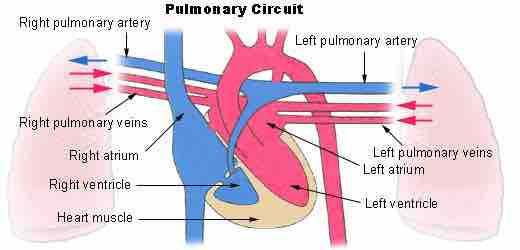The circulatory system is the continuous system of tubes through which the blood is pumped around the body. It supplies the tissues with their nutritional requirements and removes waste products. The pulmonary circulatory system circulates deoxygenated blood from the heart to the lungs via the pulmonary artery and returns it to the heart via the pulmonary vein. The systemic circulatory system circulates oxygenated blood from the heart around the body into the tissues before returning deoxygenated blood to the heart.

Pulmonary circulation
Pulmonary circulation is the half of the cardiovascular system that carries oxygen-depleted blood away from the heart to the lungs and returns oxygenated blood back to the heart.
Resistance, Pressure and Flow
Three key factors influence blood circulation.
Resistance
Resistance to flow must be overcome to push blood through the circulatory system. If resistance increases, either pressure must increase to maintain flow, or flow rate must reduce to maintain pressure. Numerous factors can alter resistance, but the three most important are vessel length, vessel radius, and blood viscosity. With increasing length, increasing viscosity, and decreasing radius, resistance is increased. The arterioles and capillary networks are the main regions of the circulatory system that generate resistance, due the small caliber of their lumen. Arterioles in particular are able to rapidly alter resistance by altering their radius through vasodilation or vasoconstriction.
The resistance offered by peripheral circulation is known as systemic vascular resistance (SVR), while the resistance offered by the vasculature of the lungs is known as pulmonary vascular resistance (PVR).
Blood Pressure
Blood pressure is the pressure that blood exerts on the wall of the blood vessels. The pressure originates in the contraction of the heart, which forces blood out of the heart and into the blood vessels. If flow is impaired through increased resistance then blood pressure must increase, so blood pressure is often used as a test for circulatory health. Blood pressure can be modulated through altering cardiac activity, vasoconstriction, or vasodilation.
Blood Flow
Flow is the movement of the blood around the circulatory system. A relatively constant flow is required by the body's tissues, so pressure and resistance are altered to maintain this consistency. A too-high flow can damage blood vessels and tissue, while flow that's too low means tissues served by the blood vessel may not receive sufficient oxygen to function.